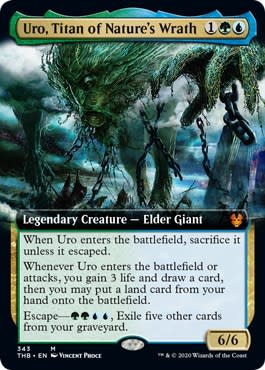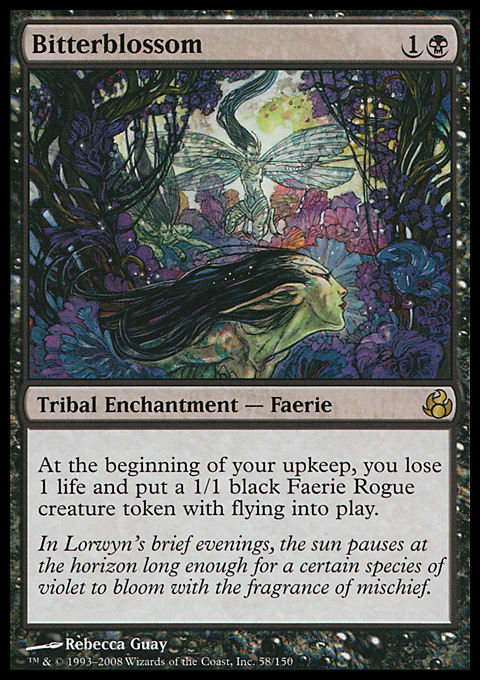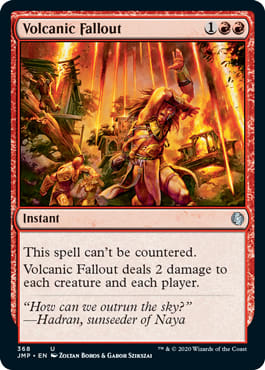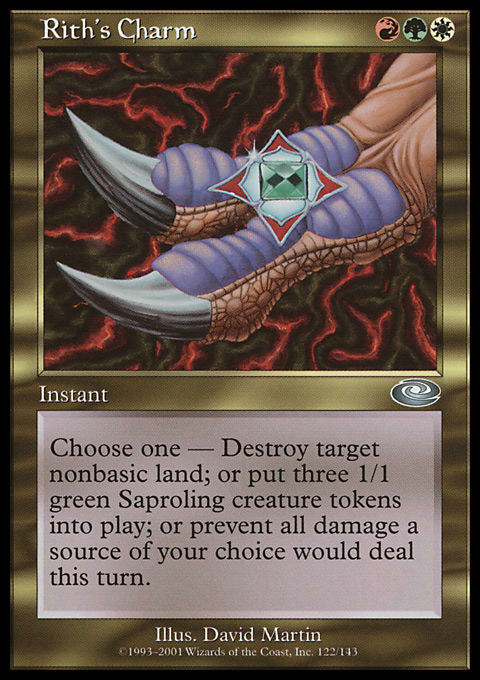ONE
ONE card was banned this week.
Sadly, I fear it was not enough.
If, in fact, we were going to ban only ONE card in Standard; I think it was the wrong one.
Uro, Titan of Nature's Wrath has caught a lot of criticism in its short existence as a Magic: The Gathering spell. A performer across multiple archetypes in Standard, never forget this is a card that also spawned a brand spanking fresh Players Tour-winning deck.
Not only does it do a lot of different things, it contributes to different strategies. Usually it is inevitable... But only if you build at least a little for it. Sometimes it's the path; other times it's the actual destination. But always does Uro at least challenge its opponents as to how they will deal with it.
I've long been a fan of the Soul-Guide Lantern, myself; as it can trigger a Monastery Swiftspear, Soul-Scar Mage, or even Heartfire Immolator... But other folks have tried the odd Skullcrack, Tibalt, or Atarka's Command depending on format.
Tough to beat? Sure.
But it's kind of like facing Akuma in Street Fighter IV ranked play. You kind of hate whoever picks him; you're halfway to disconnecting the second you see him; but every time you win, it's a little sweeter than, say, against Zangief so you're proud of yourself.
Banning Uro solves next to nothing, by the way. But we'll get to that in a second.
TWO
The nice folks in Renton, WA have caught a lot of shade the past couple of months. I am not going to sit here and type that they've done a perfect job or anything... But it would be disingenuous to claim that most of this stuff was their fault.
For instance, it wasn't really their fault that all the tournaments got cancelled.
But let's talk about what might be their fault.
Oko, Uro, Fires... Are the cards of the last couple of years really the greatest failure of development in the history of the game?
There have certainly been a lot of bans coming out of in-print sets; and I kind of shake my head every time I imagine a format where we would really see Oko and no-tax Companions at the same time as all the rest of this stuff.
But I don't think the present day is even close to the worst failure of development. There have been multiple! Consider either of these TWO pairs of TWO cards:
or
(But mostly focus on Bitterblossom).
On January 5, 2008 I had what I imagine is a unique experience playing Magic: The Gathering.
Playing for Top 8 my opponent cast a Dark Confidant and said go. I tapped 3 mana - the White of which came from a Windbrisk Heights - and cast Rith's Charm.
Passing to my own turn, I played my fourth land and attacked with my three tokens.
Prior to damage being dealt, I triggered my Windbrisk Heights, revealing this spell:
So, my opponent went to one (with a Dark Confidant in play!) and I went to three (with three Saprolings coming at him). Something could have gone wrong (probably) but I had not one but two Lightning Helixes at the ready, just in case.
So, what was the unique experience?
Was it breaking Windbrisk Heights - months before the card Spectral Procession saw print?
How about playing - fairly or not - a Biorhythm. Putting a Biorhythm in my deck?
Nah and nah dawg.
What was unique was the standing ovation. Watching me play for Top 8 the room suddenly erupted in applause as I revealed the expensive Green sorcery.
Felt great!
The previous year someone asked me why - given how many different things I could have done with my adult life - I had devoted so much time to a children's card game. Ultimately, it was for moments like this. Feelings like this. Felt great! More than that, I felt smart.
I realized relatively early on that while I could qualify for the Pro Tour with regularity, I didn't have the time to dedicate to actually mastering Magic at that level. I have made lots of decks, but I'm mostly a tuner or a problem-solver. I completely lack the inventive creativity of an Adrian Sullivan, the vision of a Patrick Chapin, or the lack of restraint unleashed when Zvi Mowshowitz really pushes the envelope.
But what I can do is feel smart. More than simply winning, that's the feeling I chase playing Magic.
Literally no one feels smart playing Bitterblossom.
I mean maybe the first guy to figure out that you won if you cast Bitterblossom on turn two? Like a week before everyone knew that? But after that first week... I don't think anyone ever felt smart playing it.
All anyone ever felt, looking back, was probably frustrated.
Bitterblossom was an overpowered, ridiculously fast, and easy-to-play threat that - while winning the game on turn two - would take a half an hour to do so. But that's not what makes it such a disaster of development.
Bitterblossom isn't just an enchantment. It's a Faerie.
Why? Because Hoofprints of the Stag is an Elemental.
How about that pair?
Why does this matter?
After some months of Bitterblossom spitting in everyone's cereal (including, often, other people playing Bitterblossom), this card was printed:
Volcanic Fallout was a card that might have initially made some Magicians feel smart. Since it can't be countered, the hated Faeries mage could not prevent it like Jund Charm. It could reliably kill all their Bitterblossom tokens!
Nice!
Bet you felt smart identifying that!
Except...
Bitterblossom is a Faerie.
This mattered when the hated, terrible, poor sport of a Faeries mage cast this card:
In a just world, killing all the opponent's Faeries would prevent Champion. So, while Mistbind Clique was also an exceptionally powerful card, there would at least be a little risk / reward thing going on. But no matter how many Faeries you killed. Despite the fact that you put in a card that can't be countered specifically so your anti-Faeries sweeper would actually resolve in response to Mistbind Clique resolving.
... They could just Champion the stupid enchantment.
So, their guy would live. All your mana would get tapped. Counter or no counter. Fallout or regular spell.
Who ever felt smart playing this combination of cards?
Playing against them?
Beyond choosing to play Faeries in the first place, I suppose. Soulless, sure; but a smart decision for certain mages, also for sure.
THREE
Which is not to say that really powerful, often format-defining, cards are always bad. One of the eternal truths of Magic is that some cards are just better than others; and identifying those (and playing with them) is a lot of where win expectation comes from.
In some cases, those cards can be really rewarding to play; and mentally stimulating as part of the process. Just to prove my point, here are THREE cards that I think are worth a discussion (though there have been countless).
- Umezawa's Jitte - It's hard to imagine a single piece of equipment more format-defining; or a card more dominating once it was already in play. Only that was only true about half the time. Brilliantly, Jitte spawned at least three sub-metagames; even in smaller formats like Kamigawa Block or Standard. The first was of course the Jitte metagame, where Jitte control and Jitte counters valuation + skill in creature combat dictated victory. This sub-metagame was all about not only how many Jittes you played but what kinds of creatures wore them (evasion, good at fighting); or even dipping into over the top anti-Jitte supplements like Manriki-Gusari. While the Jitte metagame was my favorite, there was also the Red Deck metagame! Somehow, the original Lava Spike deck emerged during Kamigawa Block Constructed - even though the entire color had been declared "dead" by the existence of Jitte and its available life gain. In Standard, Red Aggro decks (sometimes Boros, Gruul, or Bant) beat Jittes by keeping it off of opposing creatures or just going bigger. At Pro Tour Honolulu, neither $16,000 Lightning Helix casting Craig Jones nor eventual winner Mark Herberholz played Jitte main deck. Finally, there were quite a few decks - Standard AND Block - that simply ignored Jitte. They developed long game locks or combo kills, or operated either with no creatures or creatures that didn't really get into fights. Jitte was powerful. Jitte is still powerful! But over the years it's been put on everything from a Meloku token to a Hand of Cruelty before ever hearing the syllables "Stoneforge Mystic". Magic is far richer and skill testing for it.
- Simic Sky Swallower - Go ahead and read that. This is a card that, while expensive, found a way to resolve. Either it was played at the top end of UrzaTron mana bases or in slower contexts. Simic Sky Swallower was the ultimate challenger. Everyone knew it was coming, could come. How they dealt with that inevitability was, again, quite varied; challenging; and rewarding. You had Rakdos decks that tried to win before it would resolve, or Orzhov creature decks stretching into Wrath of God variants. Some Jeskai mages went to the face, knowing their Firemane Angels were tiny by comparison. And, of course, there was the odd Counterspell. Go figure.
- Stoneforge Mystic - Jon Becker once asked me what the difference between this 2-drop and Bitterblossom really was. I think it comes down to Bitterblossom being in a linear deck that was half mistake (the card itself inexplicably being a Faerie) and half built for you versus Stoneforge Mystic being half of a triumph of deck design. WotC did not initially realize how effective the card could be with so few creatures (the Mystic and frequent teammate Squadron Hawk both being so card advantageous), or for that matter with so little equipment. Batterskull was probably a little over the top, but I did appreciate the various equipment choices. Sylvok Lifestaff versus Mortarpod was a good tension. And Shuko contributing to other combination decks was another creative implementation of this card. Even today, in formats like Legacy, which Sword you play is hotly debated. And Basilisk Collar? Making your own machine gun? Come on!
Some cards are always going to be better than other cards. All three of the ones I just mentioned were at least two cuts above most of their competition, at least while they were legal in Standard. But how they were deployed, and the kinds of play that they encouraged, rewarded players. In the best of times, players got to feel smart, not just frustrated.
By comparison...
FOUR
FOUR reasons banning Uro, Titan of Nature's Wrath was not enough.
(If we proceed from the supposition that the four-color Ramp deck is too good in Standard).
This is a reasonable place to start. Six of the Top 8 of the most recent large tournament were playing Four-color Ramp decks. All of them played four copies of Omnath, Locus of Creation but not all even played four copies of Uro, Titan of Nature's Wrath!
1. Banning Uro weakens other decks more than it actually solves the Omnath problem - Per the above, not all Four-color Ramp decks even play four copies of Uro! (But they all do play four copies of Omnath). What's worse is that there might have been other implementations of some of these cards that are interesting to explore. No more. Consider:
Four-Color Waker | ZNR Standard | Phill_Hellmuth, MTGO Standard Challenge 9/21/2020
- Companion (1)
- 1 Yorion, Sky Nomad
- Creatures (8)
- 4 Uro, Titan of Nature's Wrath
- 4 Waker of Waves
- Instants (15)
- 1 Hagra Mauling
- 2 Heartless Act
- 2 Jwari Disruption
- 2 Negate
- 4 Mythos of Nethroi
- 4 Neutralize
- Sorceries (11)
- 3 Extinction Event
- 4 Agonizing Remorse
- 4 Bloodchief's Thirst
- Enchantments (12)
- 4 Confounding Conundrum
- 4 Elspeth Conquers Death
- 4 Shark Typhoon
- Lands (34)
- 1 Forest
- 4 Island
- 1 Plains
- 2 Swamp
- 1 Temple of Deceit
- 1 Temple of Enlightenment
- 4 Branchloft Pathway
- 4 Brightclimb Pathway
- 4 Clearwater Pathway
- 4 Fabled Passage
- 4 Indatha Triome
- 4 Zagoth Triome
- Sideboard (14)
- 1 Extinction Event
- 1 Heartless Act
- 2 Negate
- 3 Elder Gargaroth
- 2 Eliminate
- 3 Mystical Dispute
- 2 Scavenging Ooze
Waker of Waves is such a cool card in this deck! It's sometimes a big creature that is bigger than a 6/6 but can also severely blunt go-wide decks. Most of the time, though, it's an un-counter-able Impulse effect.
Waker of Waves feeds a short reanimator incentive with Elspeth Conquers Death, but also can make graveyard fuel for Uro, Titan of Nature's Wrath. Imagine Uro were largely played in decks like this... Is it in any way offensive? It's just synergistic and rewarding and inevitable. You might not like playing against Control decks, but probably you can appreciate what went into the card decisions in PHILL_HELLMUTH's list.
In the face of Omnath, Locus of Creation, other Ramp-style strategies pale by comparison.
2. Banning Uro doesn't actually do anything about Omnath - Sometimes we see three Beanstalk Giants. Sometimes 2-3 Cultivates. So far, no one has gone all-out on Uro AND Cultivate AND Beanstalk Giant. All that means is that there's deck design space to fill in the blank left by a now-banned Uro. Uro is singularly a stronger card than other three mana options, but it still relied on having another land handy. Among other things, Uro could not fix the one White pip on Omnath. For that purpose, Cultivate and Beanstalk Giant are both actually better. Gross.
3. It kills variety - I'd love to see a legitimate ![]()
![]() Ramp deck that uses Elspeth Conquers Death, maybe some of the new Modal Double-Faced Cards, and a split of Elder Gargaroth and Baneslayer Angel (both perfect follow ups to a Cultivate) in a different Ramp sub-niche in Standard. That deck would be better against beatdown but worse against Blue decks than its Uro cousin, although... Although NEVER MIND. Why would you try other expensive top end spells when Omnath exists and you're already devoting spell slots to Ramp and color-fixing? That's just playing Shock when you can play Lightning Bolt.
Ramp deck that uses Elspeth Conquers Death, maybe some of the new Modal Double-Faced Cards, and a split of Elder Gargaroth and Baneslayer Angel (both perfect follow ups to a Cultivate) in a different Ramp sub-niche in Standard. That deck would be better against beatdown but worse against Blue decks than its Uro cousin, although... Although NEVER MIND. Why would you try other expensive top end spells when Omnath exists and you're already devoting spell slots to Ramp and color-fixing? That's just playing Shock when you can play Lightning Bolt.
4. It feels dishonest - Come on. Who really believes Omnath is going to avoid the chopping block before 2020 is over?
FIVE
Let's end on a more positive note! Here are the Top FIVE decks that aren't Omnath or Uro.
Gruul Adventures | ZNR Standard | Camilo Mora, SCG Online Championship 9/27/2020
- Creatures (31)
- 3 Scavenging Ooze
- 4 Bonecrusher Giant
- 4 Edgewall Innkeeper
- 4 Kazandu Mammoth
- 4 Lovestruck Beast
- 4 Rimrock Knight
- 4 Robber of the Rich
- 4 Questing Beast
- Instants (3)
- 3 Spikefield Hazard
- Sorceries (4)
- 2 Primal Might
- 2 Shatterskull Smashing
- Artifacts (4)
- 4 Embercleave]
- Lands (18)
- 6 Forest
- 4 Mountain
- 2 Fabled Passage
- 2 Temple of Abandon
- 4 Cragcrown Pathway
This was going to be my pick for the top archetype in Standard (had the Omnath banning actually taking place).
Gruul Adventures has some pedigree in Standard from almost a year ago, remember; and now the mana is not only the best it's ever been... With cards like Shatterskull Smashing, it's also option-rich.
What can be better than a Questing Beast wearing an Embercleave? You better have a lot of blockers or you're taking nine, by the way!
To answer the question: A card advantageous sub-theme that also shuts off opposing aggro decks.
Gruul Landfall | ZNR Standard | Jessie Nelson, TGS Open Series
- Creatures (22)
- 2 Radha, Heart of Keld
- 4 Akoum Hellhound
- 4 Brushfire Elemental
- 4 Kazandu Mammoth
- 4 Lotus Cobra
- 4 Questing Beast
- Instants (9)
- 1 Kazuul's Fury
- 1 Valakut Awakening
- 3 Spikefield Hazard
- 4 Roiling Regrowth
- Sorceries (7)
- 3 Shatterskull Smashing
- 4 Turntimber Symbiosis
- Artifacts (4)
- 4 Embercleave
- Lands (18)
- 5 Forest
- 5 Mountain
- 4 Cragcrown Pathway
- 4 Fabled Passage
- Sideboard (15)
- 4 Bonecrusher Giant
- 3 Gemrazer
- 2 Heroic Intervention
- 2 Klothys, God of Destiny
- 3 Redcap Melee
- 1 Spikefield Hazard
The opposite number to Gruul Adventures, the Landfall version looks to recapture the glory days of Steppe Lynx and Plated Geopede.
And it might just get there!
There is a lot to love in the Landfall version, from the haste on Brushfire Elemental to the explosiveness of a surprise Roiling Regrowth.
While Gruul Landfall is not fully baked yet, it's really hard to discount any viable strategy that can put up a Questing Beast wearing an Embercleave.
Selesnya Aggro | ZNR Standard | Nick Prince, SCG Tour Online Championship Qualifier 6
- Creatures (30)
- 2 Scavenging Ooze
- 4 Basri's Lieutenant
- 4 Conclave Mentor
- 4 Luminarch Aspirant
- 4 Oran-Rief Ooze
- 4 Skyclave Apparition
- 4 Stonecoil Serpent
- 4 Swarm Shambler
- Instants (4)
- 2 Kabira Takedown
- 2 Khalni Ambush
- Sorceries (4)
- 2 Emeria's Call
- 2 Primal Might
- Artifacts (2)
- 2 Maul of the Skyclaves
- Lands (20)
- 6 Forest
- 6 Plains
- 4 Branchloft Pathway
- 4 Temple of Plenty
- Sideboard (15)
- 4 Archon of Emeria
- 2 Basri Ket
- 3 Garruk's Harbinger
- 1 Gemrazer
- 2 Glass Casket
- 2 Inscription of Abundance
- 1 Scavenging Ooze
Probably my favorite archetype in all of Standard, purely on synergy, Selesnya Aggro puts together a ton of cards that are all individually good... But combine like Voltron or Captain Planet.
Scavenging Ooze was already one of the most important finishers in the format. Now it's powered by Conclave Mentor!
Speaking of which... Conclave Mentor + Swarm Shambler + Luminarch Aspirant?
What a team, am I right?
Mono-Green Aggro | ZNR Standard | Edel, 8th Place MTGO Standard Championship Qualifier
- Creatures (27)
- 3 Gemrazer
- 4 Kazandu Mammoth
- 4 Lovestruck Beast
- 4 Scavenging Ooze
- 4 Stonecoil Serpent
- 4 Swarm Shambler
- 4 Wildwood Tracker
- Instants (4)
- 4 Ram Through
- Sorceries (8)
- 4 Primal Might
- 4 Turntimber Symbiosis
- Lands (18)
- 18 Forest
- Sideboard (15)
- 1 Gemrazer
- 1 Crawling Barrens
- 2 Elder Gargaroth
- 4 Garruk's Harbinger
- 1 Khalni Ambush
- 3 Questing Beast
- 3 Vivien, Monsters' Advocate
They said Mono-Green was done with the rotation...
But here is the eternal Mono-Green innovator, EDEL, with yet another Top 8 performing list!
I have to say that, given the improved mana, I have a hard time not slapping an Embercleave onto my Questing Beast... But this time EDEL played all the Questing Beasts in his sideboard.
This deck plays with a ton of initiative; but can also opt for card advantage and card power after sideboarding. It cheats so vigorously on lands (but makes up for that with Modal Double-Faced Cards) that both versions of Zvi Mowshowitz are probably pleased.
What a swingy day! 1-5 on one monitor with 4cOmnath - and then Winning the PTQ with 4cAdventures! I love this deck and my brain is completely fried after having played non-stop. My only loss, was to me timing out in round 1 :) haha.
— Michael Bonde (@Lampalot) September 27, 2020
Got the Que for the PT, and im so happy ?? pic.twitter.com/rACdMrtubW
Temur Adventures | ZNR Standard | lampalot, 1st Place MTGO Standard Championship Qualifier
- Creatures (26)
- 2 Brazen Borrower
- 2 Giant Killer
- 2 Lovestruck Beast
- 4 Beanstalk Giant
- 4 Bonecrusher Giant
- 4 Edgewall Innkeeper
- 4 Fae of Wishes
- 4 Omnath, Locus of Creation
- Sorceries (3)
- 3 Escape to the Wilds
- Artifacts (4)
- 4 Lucky Clover
- Lands (27)
- 2 Forest
- 6 Island
- 2 Mountain
- 1 Plains
- 2 Ketria Triome
- 2 Raugrin Triome
- 4 Branchloft Pathway
- 4 Cragcrown Pathway
- 4 Fabled Passage
Temur Adventures was always the deck that broke the rules!
A Simic-adjacent deck that was just too good - already too card advantageous - for Uro, Titan of Nature's Wrath. This was all the more remarkable given that it was the first Escape to the Wilds deck.
And here...
Oh wow.
This is embarrassing.
Is that four copies of Omnath - but only two copies of Lovestruck Beast - in a "Temur" ADVENTURES build?
How could I have missed that?
Very embarrassing to non-Bonde Michaels; this one is. Oh bother (and congratulations).
LOVE
MIKE
































